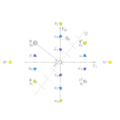Electroweak interaction facts for kids
In particle physics, the electroweak interaction is one of the four basic forces of nature. It combines two forces that seem very different in our everyday lives: electromagnetism (the force behind electricity, magnets, and light) and the weak interaction (the force responsible for radioactive decay and how the Sun produces energy). Scientists believe that at very high energies, these two forces are actually just different sides of the same coin.
Think of it like ice and water. They look different, but they are both just different forms of H₂O. In the same way, electromagnetism and the weak force are different forms of the electroweak force. This unification happens at extremely high temperatures, around 1015 K (that's a 1 followed by 15 zeros!). This temperature existed shortly after the Big Bang, during a time called the quark epoch. Since then, the universe has cooled down, and the electroweak force split into the electromagnetic and weak forces we see today. The highest temperature ever made by humans in a lab is much lower, around 5.5 trillion K, at the Large Hadron Collider.
Three scientists, Sheldon Glashow, Abdus Salam, and Steven Weinberg, won the 1979 Nobel Prize in Physics for their work on unifying these two forces. Their theory is sometimes called the Weinberg–Salam theory. The idea of the electroweak force was proven by experiments. First, in 1973, scientists found "neutral currents" in neutrino scattering. Then, in 1983, experiments at the Super Proton Synchrotron discovered the W and Z particles, which are the carriers of the weak force. In 1999, Gerardus 't Hooft and Martinus Veltman also won a Nobel Prize for showing that the electroweak theory works correctly in complex calculations.
Contents
How Scientists Discovered the Electroweak Force
After an experiment in 1956 showed that the weak interaction behaves strangely (it "violates parity"), scientists started looking for a way to connect the weak force with the electromagnetic interaction.
Sheldon Glashow was one of the first to try. He experimented with combining different types of symmetries, which are like mathematical rules that describe how particles behave. His early ideas predicted a new particle called the Z boson, but no one had seen it yet, so his work didn't get much attention at first.
In 1964, Abdus Salam and John Clive Ward had similar ideas. They predicted a massless particle (the photon, which carries the electromagnetic force) and three very heavy particles that carry the weak force.
Around 1967, Steven Weinberg was studying something called "spontaneous symmetry breaking." He found a set of symmetries that predicted a massless, neutral particle. At first, he thought this particle was useless. But then he realized his symmetries could explain the electroweak force. He even predicted the approximate masses for the W and Z bosons. Most importantly, he suggested that this new theory could be "renormalizable," meaning it could be used for accurate calculations without running into infinite values.
In 1971, Gerard 't Hooft proved that theories with spontaneously broken symmetries are indeed renormalizable, even when the force-carrying particles have mass. This was a big step forward for the electroweak theory.
How the Electroweak Force Works
In simple terms, the electroweak force is described by a mathematical framework called a "Yang–Mills field." This framework uses special groups of symmetries, like SU(2) and U(1), to describe how the force fields behave. These fields are like invisible influences that carry the force.
The particles that carry the electroweak force are initially massless. These are the three W bosons (W₁, W₂, W₃) and the B boson. However, these are not the particles we observe in nature.
In the Standard Model of particle physics, the electroweak force gets its final form through something called the Higgs mechanism. This is a special process where the Higgs field (which is everywhere in the universe) "spontaneously" breaks the electroweak symmetry. When this happens, the W and B bosons combine and change, becoming the actual particles we see: the W⁺, W⁻, and Z⁰ bosons, which are very heavy, and the photon, which remains massless.
The electric charge of a particle comes from a specific combination of "weak hypercharge" and "weak isospin." This combination is special because it does not interact with the Higgs field. This is why electromagnetism (carried by the photon) seems separate from the weak force (carried by the W and Z bosons), which *does* interact with the Higgs field.
The W₃ and B bosons mix together to form the Z⁰ boson and the photon. This mixing is described by an angle called the "weak mixing angle." This mixing also explains why the Z⁰ boson is heavier than the W bosons.
The W₁ and W₂ bosons combine to form the charged W⁺ and W⁻ bosons. These are the particles that carry the charged weak current, responsible for processes like beta decay.
Images for kids
See also
 In Spanish: Modelo electrodébil para niños
In Spanish: Modelo electrodébil para niños
- Electroweak star
- Fundamental forces
- History of quantum field theory
- Standard Model (mathematical formulation)
- Unitarity gauge
- Weinberg angle
- Yang–Mills theory





